ENERGY STAR 标准4.0
整体式LED灯的能源之星要求
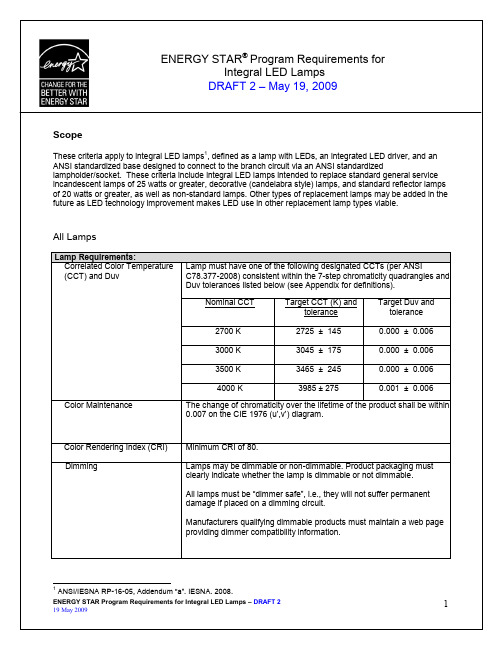
Product Packaging Language Incompatibility with Controls and Application Exceptions
In English, or English with additional languages. For products that will be sold in Canada, packaging must include both English and French. Lamp package must clearly state any known incompatibility with photo controls, dimmers or timing devices. In addition, packaging should state specific application exceptions.
1
ANSI/IESNA RP-16-05, Addendum “a”. IESNA. 2008.
ENERGY STAR Program Requirements for Integral LED Lamps – DRAFT 2 19 May 2009
1
Warranty
A warranty must be provided for lamps, covering repair or replacement for a minimum of three (3) years from the date of purchase. The written warranty must be included with the lamp packaging at the time of shipment. Lamps shall deliver at least 70% of initial lumens for at least 25,000 hours. Must be a lamp base listed in ANSI_ANSLG Standard C81.61-2007.
energy star认证新标准
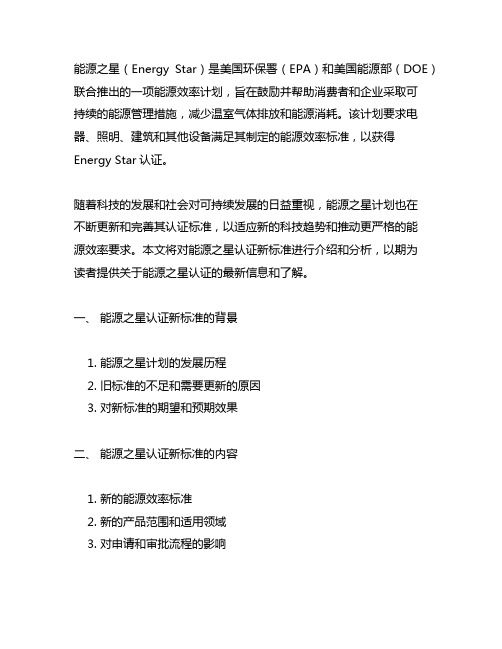
能源之星(Energy Star)是美国环保署(EPA)和美国能源部(DOE)联合推出的一项能源效率计划,旨在鼓励并帮助消费者和企业采取可持续的能源管理措施,减少温室气体排放和能源消耗。
该计划要求电器、照明、建筑和其他设备满足其制定的能源效率标准,以获得Energy Star认证。
随着科技的发展和社会对可持续发展的日益重视,能源之星计划也在不断更新和完善其认证标准,以适应新的科技趋势和推动更严格的能源效率要求。
本文将对能源之星认证新标准进行介绍和分析,以期为读者提供关于能源之星认证的最新信息和了解。
一、能源之星认证新标准的背景1. 能源之星计划的发展历程2. 旧标准的不足和需要更新的原因3. 对新标准的期望和预期效果二、能源之星认证新标准的内容1. 新的能源效率标准2. 新的产品范围和适用领域3. 对申请和审批流程的影响三、能源之星认证新标准的影响与意义1. 对企业和消费者的影响2. 对环保和可持续发展的贡献3. 对产业发展和国际合作的启示四、遵从能源之星认证新标准的挑战与应对1. 技术和成本上的挑战2. 政策和法规上的挑战3. 企业和消费者如何应对五、总结与展望1. 对新标准的评价2. 对能源之星计划的建议3. 对能源效率和可持续发展的未来展望以上是文章的大致拟定,希望对您有所帮助。
一、能源之星认证新标准的背景1. 能源之星计划的发展历程能源之星计划始于1992年,旨在提高电器和其他设备的能源效率,从而减少能源消耗和温室气体排放。
经过多年的发展,能源之星已经成为世界上最具权威和影响力的能源效率认证计划之一。
2. 旧标准的不足和需要更新的原因随着技术的不断发展,旧标准可能无法满足新型设备和技术的能源效率要求。
对能源之星认证标准的不断更新和完善是必要的。
3. 对新标准的期望和预期效果新标准的推出意味着更高的能源效率要求和更严格的认证标准,将进一步推动可持续能源管理的发展,促进更多的消费者和企业采取有效节能措施,减少能源浪费和环境污染。
能源之星认证归纳
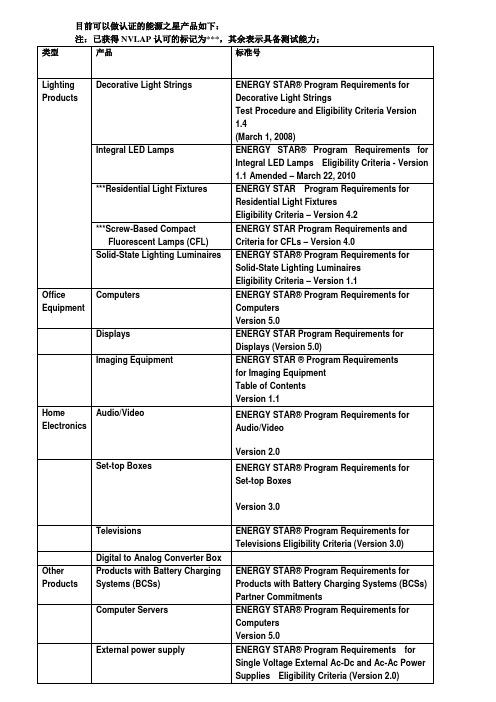
ENERGY STAR ® Program Requirements
for Imaging Equipment
Table of Contents
Version 1.1
Home Electronics
Audio/Video
ENERGY STAR® Program Requirements for Audio/Video
ENERGY STAR Program Requirements and Criteria for CFLs – Version 4.0
Solid-State Lighting Luminaires
ENERGY STAR® Program Requirements for
Solid-State Lighting Luminaires
Digital to Analog Converter Box
Other Products
Products withBatteryCharging Systems (BCSs)
ENERGY STAR® Program Requirements for
Products withBatteryCharging Systems (BCSs)
Eligibility Criteria – Version 1.1
Office Equipment
Computers
ENERGY STAR® Program Requirements for Computers
Version 5.0
Displays
ENERGY STAR Program Requirements for Displays (Version 5.0)
能源之星标准

能源之星标准解读目前Kinfine公司要求其产品达到Energy Star要求,全面了解能源之星标准要求,对我们统一认识,明确今后任务,展开商务技术会谈有着重大意义,特对能源之星标准要求做详细翻译供大家参考如下:能源之星标准的框架:能源之星认证对LED产品的要求有两个层次:第一个层次:对所有产品的要求;第二个层次:分为两类1. 非标准产品;在包装和宣传材料商不能宣称相当于现存的多少瓦德标准产品;2. 替换型产品:目标为替换如下四类灯的产品;2.1. 目标为替代ANSI C79.1 2002标准里最顶的A, R, MR, PAR等等;2.2 目标为替代直径按照八分之一英寸计算的产品如A19,MR16, PAR38;2.3 目标为替代某种名义上瓦数的产品;2.4 目标为替代某种发光角度的定向性灯的产品能源之星标准的具体要求:4) 能源之星对所有产品的要求如下:4.1色温范围必须是ANSI C78. 377-2008 标准里所规定的2700K±145, 3000K±175,3500K±245,4000K±275 四个色温范围之一;4.2颜色保持率:色品度在6000小时的测试期间内,在CIE1976 (U’,V’)图内的变化不超过0.0074.3显色性:不低于80,R9必须大于0;4.4可调光性:必须在包装上对是否可调光做明确标识,如果能够调光,制造商必须有一个网页提供调光器的兼容信息;4.5质保期:从采购日起不小于三年;4.6灯头:必须是ANSI C81.61-2007标准里列明的灯头;4.7功率因素:>5W的产品功率因素必须大于等于0.70,<5W的产品功率因素不做要求;4.7.1操作温度:能在-20度,或者更低的温度下工作;4.7.2工作频率:大于等于150Hz;4.7.3电磁干扰:需要符合FCC 47 CFR PAR15标准;4.7.4瞬间保护:电源必须符合IEE C62.41-1991的Class A标准;4.7.5工作电压:AC120V, 240V, 277V 或者是AC或者DC 12V, 24V;5)包装方面的要求;6) 非标产品:在包装和宣传材料商不能宣称相当于现存的多少瓦德标准产品;2.1.1最低效率要求:10W以下必须达到50lm/W,10W以上必须达到55lm/W;2.1.2 最小光通量:200lm;2.1.3 发光强度分布:无特殊要求,需提供goniophotometry报告;2.1.4 光通维持率:25000小时工作后光通维持率不小于70%2.1.5 快速循环压力测试:参照ANSI C78.5 LM-65-01 2, 3, 5, 6条款7) 替代产品:替代产品的要求分为如下三种7A) 全方位灯包括ANSI C79 1-2002标准里的A, BT, P, PS, S, T型产品,要求如下:7A.1 最低效率要求:10W以下必须达到50lm/W,10W以上必须达到55lm/W;7A.2 最小光通量:替换20W 不小于200lm;替换35W 不小于325lm;替换40W 不小于450lm;替换60W 不小于800lm;替换75W 不小于1100lm;替换100W 不小于1600lm;7A.3发光强度分布:参考LM-79-08标准的Section10,产品必须有均匀的光分布,在0~135度内,任何角度的光强与平均光强的差别不能超过20%,至少有5%的光通量分布在135~180度角内等等要求;7A.4 产品最大直径:不超过ANSI C78.20-2003所规定的最大直径;7A.5 产品最大长度:不超过ANSI C78.20-2003所规定的最大直径;7A.6 光通维持率:25000小时工作后光通维持率不小于70%,参考LM-79-08;7A.7 快速循环压力测试:参照ANSI C78.5 LM-65-01 2, 3, 5, 6条款7B)装饰性灯包括ANSI C79 1-2002标准里的B, BA, C, CA, DC, F, G型产品,要求如下:7B.1 最低效率要求:40lm/W;7B.2 最小光通量:替换10W 不小于70lm;替换15W 不小于90lm;替换25W 不小于150lm;替换40W 不小于300lm;替换60W 不小于500lm;7B.3 产品最大直径:不超过ANSI C78.20-2003所规定的最大直径;7B.4 光通维持率:15000小时工作后光通维持率不小于70%,参考LM-79-08;7B.5 快速循环压力测试:参照ANSI C78.5 LM-65-01 2, 3, 5, 6条款7C) 定向性灯包括ANSI C79 1-2002标准里的BR, ER, K MR, PAR, R 等产品,要求如下:7C.1 定向性灯的定义是指80%的光集中在某一个角度内的产品;7C.2 最低效率要求:产品直径在20/8 英寸以上的必须达到40lm/W,产品直径在20/8 英寸以上的必须达到45lm/W,7C.3 颜色保持率:色品度在6000小时的测试期间内,在CIE1976 (U’,V’) 图内的变化不超过0.0077C.4 产品最大直径:不超过ANSI C78.20-2003所规定的最大直径;7C.5 产品最大长度:不超过ANSI C78.20-2003所规定的最大直径;7C.6 最小光输出:等于被替代灯所消耗瓦数*10;7C.7 PAR灯和MR16灯的中心光强要求:能源之星给出了一个网站,上面可以计算要求的最小中心光强;PAR灯:/htmlemail/energystar/dec09/eslntlampcenterbeamtool.zip MR16灯:/htmlemail/energystar/dec09/eslntlampcenterbeamtool.zip 7C.8 光通维持率:25000小时工作后光通维持率不小于70%,参考LM-79-08;7C.9 快速循环压力测试:参照ANSI C78.5 LM-65-01 2, 3, 5, 6条款能源之星关于光通维持率的要求如下:整灯测试6000小时,根据对应的光衰做寿命声明6000小时光通维持率允许-3%公差允许宣称的寿命装饰性灯最低要求86.70% 15000装饰性灯附加标准89.90% 20000非标准灯,全方向型灯最低要求,以及定向型,装饰型灯的选择性标准91.80% 2500093.1%% 3000094.1%% 3500094.8%% 4000095.4%% 45000所有类型灯选择性标准95.8%% 50000如果要宣称更长的寿命时间,按照以下标准:要求的最少测试时间测试完成后要求达到的最低光通维持率允许-3%公差允许宣称的寿命7500 91.20% 300008750 91.50% 3500010000 91.50% 4000012500 91.80% 45000 测试温度:非标准灯以及全方位型灯:10W以下的,测试温度为25度;非标准灯以及全方位型灯:10W以上的,测试温度为45度;装饰类的灯:25度;曾波2011-3-2。
能源之星4.0版本部分中文标准
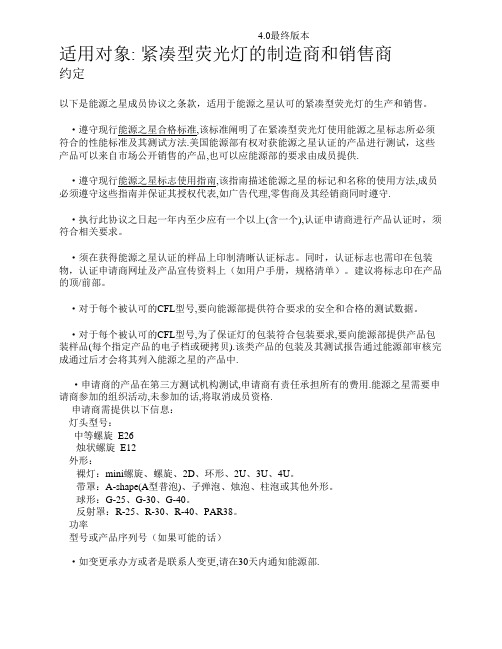
4.0最终版本适用对象: 紧凑型荧光灯的制造商和销售商约定以下是能源之星成员协议之条款,适用于能源之星认可的紧凑型荧光灯的生产和销售。
·遵守现行能源之星合格标准,该标准阐明了在紧凑型荧光灯使用能源之星标志所必须符合的性能标准及其测试方法.美国能源部有权对获能源之星认证的产品进行测试,这些产品可以来自市场公开销售的产品,也可以应能源部的要求由成员提供.·遵守现行能源之星标志使用指南,该指南描述能源之星的标记和名称的使用方法,成员必须遵守这些指南并保证其授权代表,如广告代理,零售商及其经销商同时遵守.·执行此协议之日起一年内至少应有一个以上(含一个),认证申请商进行产品认证时,须符合相关要求。
·须在获得能源之星认证的样品上印制清晰认证标志。
同时,认证标志也需印在包装物,认证申请商网址及产品宣传资料上(如用户手册,规格清单)。
建议将标志印在产品的顶/前部。
·对于每个被认可的CFL型号,要向能源部提供符合要求的安全和合格的测试数据。
·对于每个被认可的CFL型号,为了保证灯的包装符合包装要求,要向能源部提供产品包装样品(每个指定产品的电子档或硬拷贝).该类产品的包装及其测试报告通过能源部审核完成通过后才会将其列入能源之星的产品中.·申请商的产品在第三方测试机构测试,申请商有责任承担所有的费用.能源之星需要申请商参加的组织活动,未参加的话,将取消成员资格.申请商需提供以下信息:灯头型号:中等螺旋 E26烛状螺旋 E12外形:裸灯:mini螺旋、螺旋、2D、环形、2U、3U、4U。
带罩:A-shape(A型普泡)、子弹泡、烛泡、柱泡或其他外形。
球形:G-25、G-30、G-40。
反射罩:R-25、R-30、R-40、PAR38。
功率型号或产品序列号(如果可能的话)·如变更承办方或者是联系人变更,请在30天内通知能源部.可采取的特殊方案为了赢得美国能源部更好的认可和支持,能源之星成员可以采取以下自愿的方式,并应在实施过程中将进展情况及时通知能源部.·提高公司设备的能源效率的改进.·购买带能源之星标记的产品:修改公司产品采购计划并向美国能源部提供采购人员名单及联系方式;向员工宣传贴有能源之星标志产品的一般知识,并鼓励他们购买.·保证公司设备中所有在用的能源之星认可的监控器都具备电源管理功能尤其是进行安装和售后服务时..·对那些工作与公司现有的能源之星认证产品类型的开发、营销、销售和服务等相关人员宣传能源之星的一般知识。
LED灯泡能源之星标准中文版
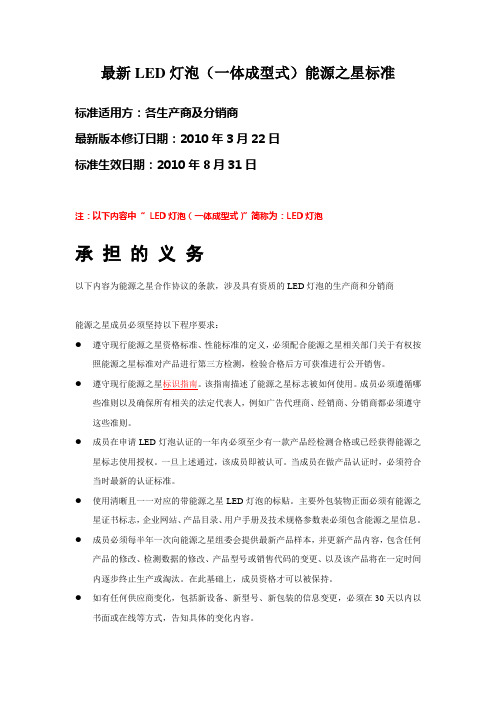
最新LED灯泡(一体成型式)能源之星标准标准适用方:各生产商及分销商最新版本修订日期:2010年3月22日标准生效日期:2010年8月31日注:以下内容中“LED灯泡(一体成型式)”简称为:LED灯泡承担的义务以下内容为能源之星合作协议的条款,涉及具有资质的LED灯泡的生产商和分销商能源之星成员必须坚持以下程序要求:●遵守现行能源之星资格标准、性能标准的定义,必须配合能源之星相关部门关于有权按照能源之星标准对产品进行第三方检测,检验合格后方可获准进行公开销售。
●遵守现行能源之星标识指南。
该指南描述了能源之星标志被如何使用。
成员必须遵循哪些准则以及确保所有相关的法定代表人,例如广告代理商、经销商、分销商都必须遵守这些准则。
●成员在申请LED灯泡认证的一年内必须至少有一款产品经检测合格或已经获得能源之星标志使用授权。
一旦上述通过,该成员即被认可。
当成员在做产品认证时,必须符合当时最新的认证标准。
●使用清晰且一一对应的带能源之星LED灯泡的标贴。
主要外包装物正面必须有能源之星证书标志,企业网站、产品目录、用户手册及技术规格参数表必须包含能源之星信息。
●成员必须每半年一次向能源之星组委会提供最新产品样本,并更新产品内容,包含任何产品的修改、检测数据的修改、产品型号或销售代码的变更、以及该产品将在一定时间内逐步终止生产或淘汰。
在此基础上,成员资格才可以被保持。
●如有任何供应商变化,包括新设备、新型号、新包装的信息变更,必须在30天以内以书面或在线等方式,告知具体的变化内容。
●对于每一类产品,必须提供官方认可的检测机构出具的符合能源之星产品性能标准的检测报告。
●每一个分类产品必须提供电子版或者复印件形式的包装样式报告,只有产品性能和包装检测结果均合格,才能进入合格产品目录。
●组委会将任意抽选某一成员的产品进行第三方检测,检测相关费用由成员承担,如成员拒绝接受检测,则其成员资格将被免除。
●每半年提交一次产品出货信息,特别是符合能源之星标准产品出货的总量,信息提交时应写明以下信息:灯头类型ANSI标准外形型号全向灯:A、BT、P、PS、S、T装饰灯:B、BA、C、CA、DC、F、G定向灯:BR、ER、K、MR、PAR、R非标准的:功率数产品编号(如果有)能源之星希望成员能主动提供出货总量信息及其中能源之星产品在总数中所占品种及百分比。
ENERGY STAR Final Version 4.0 Room Air Conditioners Cover Memo
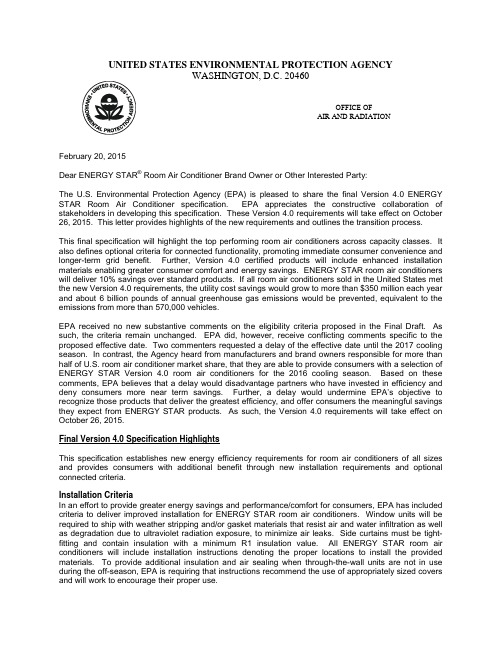
UNITED STATES ENVIRONMENTAL PROTECTION AGENCYWASHINGTON, D.C. 20460OFFICE OFAIR AND RADIATIONFebruary 20, 2015Dear ENERGY STAR® Room Air Conditioner Brand Owner or Other Interested Party:The U.S. Environmental Protection Agency (EPA) is pleased to share the final Version 4.0 ENERGY STAR Room Air Conditioner specification. EPA appreciates the constructive collaboration of stakeholders in developing this specification. These Version 4.0 requirements will take effect on October 26, 2015. This letter provides highlights of the new requirements and outlines the transition process.This final specification will highlight the top performing room air conditioners across capacity classes. It also defines optional criteria for connected functionality, promoting immediate consumer convenience and longer-term grid benefit. Further, Version 4.0 certified products will include enhanced installation materials enabling greater consumer comfort and energy savings. ENERGY STAR room air conditioners will deliver 10% savings over standard products. If all room air conditioners sold in the United States met the new Version 4.0 requirements, the utility cost savings would grow to more than $350 million each year and about 6 billion pounds of annual greenhouse gas emissions would be prevented, equivalent to the emissions from more than 570,000 vehicles.EPA received no new substantive comments on the eligibility criteria proposed in the Final Draft. As such, the criteria remain unchanged. EPA did, however, receive conflicting comments specific to the proposed effective date. Two commenters requested a delay of the effective date until the 2017 cooling season. In contrast, the Agency heard from manufacturers and brand owners responsible for more than half of U.S. room air conditioner market share, that they are able to provide consumers with a selection of ENERGY STAR Version 4.0 room air conditioners for the 2016 cooling season. Based on these comments, EPA believes that a delay would disadvantage partners who have invested in efficiency and deny consumers more near term savings. Further, a delay would undermine EPA’s objective to recognize those products that deliver the greatest efficiency, and offer consumers the meaningful savings they expect from ENERGY STAR products. As such, the Version 4.0 requirements will take effect on October 26, 2015.Final Version 4.0 Specification HighlightsThis specification establishes new energy efficiency requirements for room air conditioners of all sizes and provides consumers with additional benefit through new installation requirements and optional connected criteria.Installation CriteriaIn an effort to provide greater energy savings and performance/comfort for consumers, EPA has included criteria to deliver improved installation for ENERGY STAR room air conditioners. Window units will be required to ship with weather stripping and/or gasket materials that resist air and water infiltration as well as degradation due to ultraviolet radiation exposure, to minimize air leaks. Side curtains must be tight-fitting and contain insulation with a minimum R1 insulation value. All ENERGY STAR room air conditioners will include installation instructions denoting the proper locations to install the provided materials. To provide additional insulation and air sealing when through-the-wall units are not in use during the off-season, EPA is requiring that instructions recommend the use of appropriately sized covers and will work to encourage their proper use.Optional Connected CriteriaThis specification also establishes optional connected criteria for room air conditioners. ENERGY STAR room air conditioners with connected functionality offer a significant opportunity for demand response programs, since they are operational during peak energy demand times. The Delay Appliance Load and Temporary Appliance Load Reduction criteria protect consumers from extreme temperatures by including an 85 degree Fahrenheit maximum adjusted set temperature limit, and including consumer override provisions. ENERGY STAR room air conditioners with connected functionality will offer consumers new convenience and energy-saving features, such as the ability to turn off the unit remotely when not at home, and feedback on the energy use of the product. These products will also be smart-grid ready, meaning they will give consumers the option to connect their room air conditioner with their local utility to potentially save money on their energy bills, where those services are offered, and also facilitate broader electric power system efficiency.DOE is planning to develop a test method to validate the demand response capabilities of room air conditioners. The 5% allowance for connected functionality will not be available until after publication of the final test method. After publication, products must be certified using this final and validated ENERGY STAR test method for demand response in order to be identified on the Qualified Products List has offering connected functionality and to make use of the 5% allowance.Sound PerformanceDuring development of this specification, EPA heard from many manufacturers that increasing fan speeds continues to be a low-cost option for improving room air conditioner efficiency, suggesting a relationship between efficiency and noise. The Agency is not including sound performance criteria in this specification, in consideration of the associated testing and cost burdens and challenges. However, in the interest of maintaining a positive consumer experience, EPA strongly encourages manufacturers to consider potential impacts to sound performance as they make design decisions to meet the ENERGY STAR efficiency levels. EPA will continue to engage manufacturers to understand their evolving capabilities for sound performance testing, watch for concerns around noise associated with ENERGY STAR RAC, and will reconsider a requirement in a future specification, as needed.EPA understands, based on conversations with multiple manufacturers and brand owners, that they will leverage a suite of options to achieve ENERGY STAR efficiency levels. Among the technology advances available to manufacturers, EPA encourages the adoption of alternative refrigerants in accordance with EPA’s Significant New Alternatives Policy (SNAP) program.Version 4.0 Transition Timeline and Next Steps:EPA shares partners’ desire for a smooth transition from one ENERGY STAR specification version to the next so that consumer expectations are met, and ENERGY STAR labeled products fully meet the new requirements upon their effective date. With this in mind, EPA has established the following timeline: •Effective immediately, manufacturers may elect to have their Certification Body (CB) certify eligible products to the Version 4.0 requirements.•After June 30, 2015, CBs will be instructed to stop certifying new product submittals to Version3.1. Note, however, that existing certifications to Version 3.1 will remain valid for the purposes ofENERGY STAR certification until October 26, 2015.•Any room air conditioner manufactured as of October 26, 2015, must meet the Version 4.0 requirements to bear the ENERGY STAR mark. All certifications of products to the Version 3.1 specification will be invalid for purposes of ENERGY STAR and CBs will only submit product models certified to Version 4.0 to EPA.EPA thanks all stakeholders who provided feedback during this specification revision process and looks forward to working with you as you qualify and market your ENERGY STAR room air conditioners. Please direct any specific questions to Melissa Fiffer, EPA, at fiffer.melissa@, 202-343-9494. Room air conditioner test method questions should be directed to Bryan Berringer, DOE, at Bryan.Berringer@ or 202-586-0371. Thank you for your continued support of the ENERGY STAR program.Sincerely,Melissa Fiffer, Product ManagerENERGY STAR Appliances。
4.0 Energy Star 认证程序说明 ( 中文版)

P. 灯:一种人造光源的一般术语。
广义的来讲,就是表示能发出可见光的物体。
Q. 灯和镇流器的平台:是一组镇流器和一个或多个灯同时运作在一个镇流器上。
这唯一的平台是以镇流器的制造商、镇流器的型号、灯管和灯管在镇流器上运作时的数量来定义它的。
R. 灯电流波峰系数:对于60Hz的工作频率,波峰系数是峰值电流与电流均方根(RMS)的比。
对于高频镇流器,是最高的峰值电流和电流均方根之比。
(在一个完整的电压循环后进行评估)S. 灯座:灯具的一个能给灯管提供电源并且有放置灯管的地方的部件。
T. 灯具(光源):由一个灯或多个灯和镇流器(如提供)组成的一整套灯,包括用来安装和保护灯,并使灯与电源供应器相连接的部分。
U. 线型荧光灯:一个双灯座的节能荧光灯附带插座式灯座的装置,有直管或U型管双端灯管。
V. 电感式镇流器:使用一个磁心和用铜缠绕的镇流器是以线形电压的频率来运作的。
W. MRA:共同认可的安排。
X. NACLA:国家试验室鉴定协会(NVLAP签署)。
Y. NEMA:国家电子制造商协会。
Z. NFPA:国家防火协会(美国)公布的国际电器规程(NEC)。
AA. N RTL:国家认可测试实验室程序,它是技术支持OSHA董事会的一部分。
BB. NVLAP:国家自愿实验室委托程序。
CC. 光学仪器:包括反射体、隔珊、透镜和/或扩散体,并且所有来控制灯位置和结构分配的总称。
DD. O SHA:职业安全和健康行政部门。
EE. 末端:一个有两个连接器的短线。
每一端都能在两个连接器之间转换;还指一个螺旋灯头适配器和插座适配器。
FF. 功率因数:实际功率除以产品标签上的功率。
(例如:一个产品的输入电压的值乘以一个镇流器输入的电流值)GG. 嵌入式花样筒灯:一种非线型的光单元,包括灯,镇流器,光学,修饰和电源连接设计,用来把一个能效源转换成白炽灯或卤素吸顶灯或非吸顶式嵌入密封式的灯具。
HH. 标准色标:定义的一块具有并列染色性的椭圆形区域,一个质心,一个垂直的轴线上倾斜的三角比和一个水平变化的区域。
各国能效要求标准

Table 1: Energy-Efficiency Criteria for Ac-Ac and Ac-Dc External Power Suppliesin Active Mode: Standard Models (普通机型)Nameplate Output Power (Pno)0 to ≤ 1 watt > 1 to ≤ 49 watts > 49 wattsTable 2: Energy-Efficiency Criteria for Ac-Ac anin Active Mode: Low Voltage Models (低电压机型) 电压≤6V并且电流≥550mANameplate Output Power (Pno)0 to ≤ 1 watt> 1 to ≤ 49 watts > 49 wattsTable 4: Energy Consumption Criteria for No-Lo(空载功耗)0 to < 50 watts ≥ 50 to ≤ 250 watts另外对于输入功率大于或等于100W 的外部电源还要求功率因素必需大于或等于0.9(能效等级4 空载功耗.0标准Nameplate Output Power (Pno)(能效等级4).0标准a for Ac-Ac and Ac-Dc External Power Supplies(普通机型)Minimum Average Efficiency in Active Mode (expressed as adecimal) 2≥ 0.480 * P no + 0.1400.8446≥ [0.0626 * Ln (P no )] + 0.6220.71≥ 0.870Ac and Ac-Dc External Power Suppliesodels (低电压机型) 电压≤6V并且电流≥550mAMinimum Average Efficiency in Active Mode (expressed as adecimal) 2≥ 0.497 * P no + 0.067≥ [0.0750 * Ln (P no )] + 0.5610.704216≥ 0.860Pno 是铭牌上标的功率No-Load (空载功耗)Ac-Ac EPSAc-Dc EPS ≤ 0.5 watts ≤ 0.3watts ≤ 0.5 watts≤ 0.5watts的外部电源还要求功率因素必需大于或等于0.9Maximum Power in No-Load牌上标的功率。
美国能源之星的标准
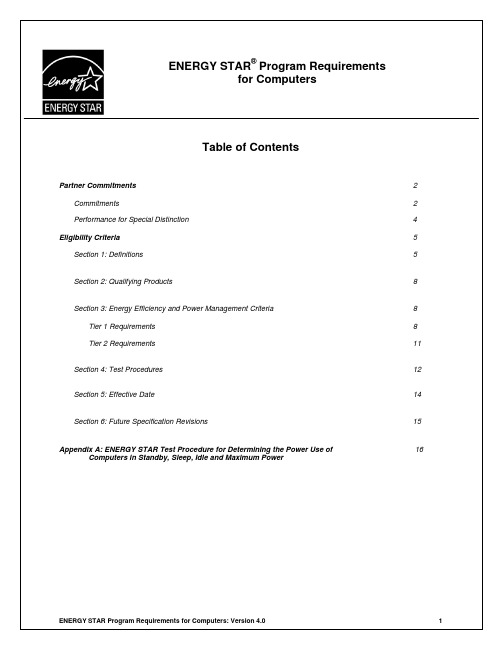
2. In product literature (i.e., user manuals, spec sheets, etc.);3. On product packaging for products sold at retail; and4. On the manufacturer’s Internet site where information about ENERGY STAR qualified models isdisplayed:− If information concerning ENERGY STAR is provided on the Partner Web site, as specified by the ENERGY STAR Web Linking Policy (this document can be found in the PartnerResources section on the ENERGY STAR Web site at ), EPA mayprovide links where appropriate to the Partner Web site;• agree to complete steps to educate users of their products about the benefits of power management by including the following information, in addition to that described in the User InformationRequirements found in the ENERGY STAR Eligibility Criteria (Section 3.A.3), with each computer (i.e., in the user manual or on a box insert):1. Energy saving potential;2. Financial saving potential;3. E nvironmental benefits4. Information on ENERGY STAR and a link to ; and5. ENERGY STAR logo (used in accordance with "The ENERGY STAR Identity Guidelines"available at /logos).In addition to the information contained with the product, the manufacturer will have similar information with a link to /powermanagement on the company Web site, readily accessible from computer product pages, product specifications, and related content pages.At the manufacturer’s request, EPA will supply suggested facts and figures related to the abovecriteria, template elements, or a complete template suitable for use in user guides or box inserts.EPA's goal is to achieve a 40% power management enabling rate nationally by 2010; 60% by 2012;and > 80% by 2014. EPA recognizes the importance of documenting enabling rates and encourages industry to develop a collective strategy for securing and funding this research, and sharing findings with EPA and the public.• provide to EPA, on an annual basis, an updated list of ENERGY STAR qualified computer models.Once the Partner submits its first list of ENERGY STAR qualified computer models, the Partner will be listed as an ENERGY STAR Partner. Partner must provide annual updates in order to remain on the list of participating product manufacturers;• provide to EPA, on an annual basis, unit shipment data or other market indicators to assist in determining the market penetration of ENERGY STAR. Specifically, Partner must submit the total number of ENERGY STAR qualified computers shipped (in units by model) or an equivalentmeasurement as agreed to in advance by EPA and Partner. Partner is also encouraged to provide ENERGY STAR qualified unit shipment data segmented by meaningful product characteristics (e.g., capacity, size, speed, or other as relevant), total unit shipments for each model in its product line, and percent of total unit shipments that qualify as ENERGY STAR. The data for each calendar yearshould be submitted to EPA, preferably in electronic format, no later than the following March and may be provided directly from the Partner or through a third party. The data will be used by EPA only for program evaluation purposes and will be closely controlled. Any information used will be masked by EPA so as to protect the confidentiality of the Partner;• notify EPA of a change in the designated responsible party or contacts for computers within 30 days.Performance for Special DistinctionIn order to receive additional recognition and/or support from EPA for its efforts within the Partnership, the ENERGY STAR Partner may consider the following voluntary measures and should keep EPA informed on the progress of these efforts:• consider energy efficiency improvements in company facilities and pursue the ENERGY STAR mark for buildings;• purchase ENERGY STAR qualified products. Revise the company purchasing or procurement specifications to include ENERGY STAR. Provide procurement officials’ contact information to EPA for periodic updates and coordination. Circulate general ENERGY STAR qualified product information to employees for use when purchasing products for their homes;• ensure the power management feature is enabled on all ENERGY STAR qualified monitors and computers in use in company facilities, particularly upon installation and after service is performed; • provide general information about the ENERGY STAR program to employees whose jobs are relevant to the development, marketing, sales, and service of current ENERGY STAR qualified productmodels;• provide a simple plan to EPA outlining specific measures Partner plans to undertake beyond the program requirements listed above. By doing so, EPA may be able to coordinate, communicate, and/or promote Partner’s activities, provide an EPA representative, or include news about the event in the ENERGY STAR newsletter, on the ENERGY STAR Web pages, etc. The plan may be as simple as providing a list of planned activities or planned milestones that Partner would like EPA to be aware of. For example, activities may include: (1) increase the availability of ENERGY STAR qualified products by converting the entire product line within two years to meet ENERGY STAR guidelines; (2) demonstrate the economic and environmental benefits of energy efficiency through special in-store displays twice a year; (3) provide information to users (via the Web site and user’s manual) about energy-saving features and operating characteristics of ENERGY STAR qualified products: and (4) build awareness of the ENERGY STAR Partnership and brand identity by collaborating with EPA on one print advertorial and one live press event;• provide quarterly, written updates to EPA as to the efforts undertaken by Partner to increase availability of ENERGY STAR qualified products, and to promote awareness of ENERGY STAR and its message.Below is the Version 4.0 product specification for ENERGY STAR qualified computers. A product mustF. D esktop-Derived Server: A desktop-derived server is a computer that typically uses desktopcomponents in a tower form factor, but is designed explicitly to be a host for other computers or applications. For the purposes of this specification, a computer must be marketed as a server and have the following characteristics to be considered a desktop-derived server:• Designed and placed on the market as a Class B product per EuroNorm EN55022:1998 under the EMC Directive 89/336/EEC and has no more than single processor capability (1 socket on board);• Designed in a pedestal, tower, or other form factor similar to those of desktop computers such that all data processing, storage, and network interfacing is contained within one box/product;• Designed to operate in a high-reliability, high-availability application environment where the computer must be operational 24 hours/day and 7 days/week, and unscheduled downtime is extremely low (on the order of hours/year);• Capable of operating in a simultaneous multi-user environment serving several users through networked client units; and• Shipped with an industry accepted operating system for standard server applications (e.g., Windows NT, Windows 2003 Server, Mac OS X Server, OS/400, OS/390, Linux, Unix andSolaris).Desktop-derived servers are designed to perform functions such as processing information for other systems, providing network infrastructure services (e.g., archiving), data hosting and running web servers.This specification does not cover mid-range or large servers, defined for purposes of thisspecification as:• Designed and placed on the market as a Class A product per EuroNorm EN55022:1998 under the EMC Directive 89/336/EEC and designed and capable of having a single or dualprocessor capability (1 or greater sockets on board);• Placed on the market as a Class B product, but hardware upgraded from a Class A product, per EuroNorm EN55022:1998 under the EMC Directive 89/336/EEC and designed capable of having a single or dual processor capability (1 or greater sockets on board); and • Designed and placed on the market as a Class B product per EuroNorm EN55022:1998 under the EMC Directive 89/336/EEC and designed and capable of having a minimum dualprocessor capability (2 sockets on board).G. Game Consoles: Stand alone computers whose primary use is to play video games. For thepurposes of this specification, game consoles must use a hardware architecture based on typical computer components (e.g., processors, system memory, video architecture, optical and/or hard drives, etc.). The primary input for game consoles are special hand held controllers rather than the mouse and keyboard used by more conventional computer types. Game consoles are also equipped with audio visual outputs for use with televisions as the primary display, rather than an external monitor or integrated display. These devices do not typically use a conventionaloperating system, but often perform a variety of multimedia functions such as: DVD/CD playback, digital picture viewing, and digital music playback.H. Integrated Computer: A desktop system in which the computer and display function as a singleunit which receives its ac power through a single cable. Integrated computers come in one of twopossible forms: (1) a system where the display and computer are physically combined into a single unit; or (2) a system packaged as a single system where the display is separate but is connected to the main chassis by a dc power cord and both the computer and display arepowered from a single power supply. As a subset of desktop computers, integrated computers are typically designed to provide similar functionality as desktop systems.I. Notebook and Tablet Computers: A computer designed specifically for portability and to beoperated for extended periods of time without a direct connection to an ac power source.Notebooks and tablets must utilize an integrated monitor and be capable of operation off an integrated battery or other portable power source. In addition, most notebooks and tablets use an external power supply and have an integrated keyboard and pointing device, though tablets use touch-sensitive screens. Notebook and tablet computers are typically designed to provide similar functionality to desktops except within a portable device. For the purposes of this specification, docking stations are considered accessories and therefore, the performance levels associated with notebooks presented in Table 1 of Section 3, below, do not include them.J. W orkstation: For the purposes of this specification, to qualify as a workstation, a computer must: • Be marketed as a workstation;• Have a mean time between failures (MTBF) of at least 15,000 hours based on either Bellcore TR-NWT-000332, issue 6, 12/97 or field collected data; and• Support error-correcting code (ECC) and/or buffered memory.In addition, a workstation must meet three of the following six optional characteristics:• Have supplemental power support for high-end graphics (i.e., PCI-E 6-pin 12V supplemental power feed);• System is wired for greater than x4 PCI-E on the motherboard in addition to the graphics slot(s) and/or PCI-X support;• Does not support Uniform Memory Access (UMA) graphics;• Includes 5 or more PCI, PCIe or PCI-X slots;• Capable of multi-processor support for two or more processors (must support physically separate processor packages/sockets, i.e., not met with support for a single multi coreprocessor); and/or• Be qualified by at least 2 Independent Software Vendor (ISV) product certifications; these certifications can be in process, but must be completed within 3 months of qualification. Operational ModesK. Idle State: For purposes of testing and qualifying computers under this specification, this is the state in which the operating system and other software have completed loading, the machine is not asleep, and activity is limited to those basic applications that the system starts by default.L. S leep Mode: A low power state that the computer is capable of entering automatically after a period of inactivity or by manual selection. A computer with sleep capability can quickly “wake” in response to network connections or user interface devices. For the purposes of this specification, Sleep mode correlates to ACPI System Level S3 (suspend to RAM) state, where applicable.M. Standby Level (Off Mode): The power consumption level in the lowest power mode which cannot be switched off (influenced) by the user and that may persist for an indefinite time when the appliance is connected to the main electricity supply and used in accordance with themanufacturer’s instructions. For purposes of this specification, Standby correlates to ACPISystem Level S4 or S5 states, where applicable.Networking and Power ManagementN. Network Interface: The components (hardware and software) whose primary function is to makethe computer capable of communicating over one or more network technologies. For purposes of testing to this specification, Network Interface refers to the IEEE 802.3 wired Ethernet interface. O. Wake Event: A user, programmed, or external event or stimulus that causes the computer totransition from Sleep or Standby to active mode of operation. Examples of wake events include, but are not limited to: movement of the mouse, keyboard activity, or a button press on the chassis, and in the case of external events, stimulus conveyed via a remote control, network, modem, etc. P. Wake On LAN (WOL): Functionality which allows a computer to wake from Sleep or Standbywhen directed by a network request.2) Qualifying Products: Computers must meet the computer definition as well as one of theproduct type definitions provided in Section 1, above, to qualify as ENERGY STAR. Please note that EPA will explore additional computer types, such as thin clients, for potential Tier 2requirements. The following table provides a list of the types of computers that are (and are not) eligible for ENERGY STAR.Products Covered by Version 4.0SpecificationProducts Not Covered by Version 4.0 Specification a. b. c. d. e. f. Desktop ComputersGame ConsolesIntegrated Computer SystemsNotebook Computers/Tablet PCsDesktop-Derived ServersWorkstations g. Mid-Range and Large Servers (as defined in Section 1F) h. Thin Clients/Blade PCs i. Handhelds and PDAs3) Energy Efficiency and Power Management Criteria: Computers must meet therequirements below to qualify as ENERGY STAR. Effective dates for Tier 1 and Tier 2 are covered in Section 5 of this specification.A) Tier 1 Requirements - Effective July 20, 2007(1) Power Supply Efficiency RequirementsComputers Using an Internal Power Supply: 80% minimum efficiency at 20%, 50%, and 100% of rated output and Power Factor > 0.9 at 100% of rated output.Computers Using an External Power Supply: Must be ENERGY STAR qualified or meet the no-load and active mode efficiency levels provided in the ENERGY STAR Program Requirements for Single Voltage Ac-Ac and Ac-Dc External Power Supplies. The ENERGY STAR specification and qualified product list can be found at /powersupplies . Note: This performance requirement also applies to multiple voltage output external power supplies as tested in accordance to the Internal Power Supply test method referenced in Section 4, below.(2) Operational Mode Efficiency RequirementsDesktop Categories for Idle Criteria: For the purposes of determining Idle state levels, desktops (including integrated computers, desktop-derived servers and game consoles) must qualify under Categories A, B, or C as defined below:Category A: All desktop computers that do not meet the definition of either Category B orCategory C below will be considered under Category A for ENERGY STAR qualification.Category B: To qualify under Category B desktops must have:•Multi-core processor(s) or greater than 1 discrete processor; and•Minimum of 1 gigabyte of system memory.Category C: To qualify under Category C desktops must have:•Multi-core processor(s) or greater than 1 discrete processor; and• A GPU with greater than 128 megabytes of dedicated, non-shared memory.In addition to the requirements above, models qualifying under Category C must be configured with a minimum of 2 of the following 3 characteristics:•Minimum of 2 gigabytes of system memory;•TV tuner and/or video capture capability with high definition support; and/or•Minimum of 2 hard disk drives.Notebook Categories for Idle Criteria: For the purposes of determining Idle state levels, notebooks and tablets must qualify under Categories A or B as defined below:Category A: All notebook computers that do not meet the definition of Category B below will be considered under Category A for ENERGY STAR qualification.Category B: To qualify under Category B notebooks must have:• A GPU with a minimum of 128 megabytes of dedicated, non-shared memory.Workstation Levels: Workstation levels will be determined using a simplified Typical Electricity Consumption (TEC) approach to allow manufacturers energy trade offs between different operating modes, based on a given weighting factor for each mode. The final level will be based on the TEC power level (P TEC) which will be determined by the following formula:P TEC = 0.1 * P Standby + 0.2 * P Sleep + 0.7 * P Idlewhere, P Standby is the power measured in Standby, P Sleep is the power measured in Sleep, and in P Idle is the power measured in Idle. This P TEC value will then be compared to the TEC budget which is determined by a fixed percentage of the maximum power of the system, including an adder for installed hard drives as indicated in the equation in Table 1. The test procedure for determining the maximum power of workstations can be found in Section 4 of Appendix A.Power Level Requirements: The following tables indicate the required power allowances for the Tier 1 specification. Table 1 gives the baseline requirements, while Table 2 gives additional power allowances for WOL. For those products that meet the WOL enabling requirement for either Sleep or Standby, a model must meet the energy level provided in Table 1 summed with the appropriate allowances from Table 2. Note: Products whose Sleep levels meet the Standby power requirements do not need to have a distinct Standby (Off mode), and may qualify for this specification using only Sleep mode.Table 1: Tier 1 Energy Efficiency Requirements Product Type Tier 1 RequirementsDesktops, Integrated Computers, Desktop-Derived Servers and GamingConsoles Standby (Off Mode): ≤ 2.0 WSleep Mode: ≤ 4.0 WIdle State:Category A: ≤ 50.0 WCategory B: ≤ 65.0 WCategory C: ≤ 95.0 WNote: Desktop-derived servers (as defined in section 1. F) are exempt from the Sleep level above.Notebooks and Tablets Standby (Off Mode): ≤ 1.0 W Sleep Mode: ≤ 1.7 WIdle State:Category A: ≤ 14.0 WCategory B: ≤ 22.0 WWorkstations TEC Power (P TEC):≤ 0.35 * [P Max + (# HDDs * 5)] WNote: Where P max is the maximumpower drawn by the system as testedper the test procedure in Section 4 ofAppendix A, and #HDD is the number of installed hard drives in the system.Table 2: Tier 1 Capability Adder for Sleep and StandbyCapability Additional Power Allowance Wake On LAN (WOL) + 0.7 W for Sleep+ 0.7 W for StandbyQualifying Computers with Power Management Capabilities: The following requirements should be followed when determining whether models should be qualified with or without WOL:Standby: Computers should be tested and reported as shipped for Standby. Models that will be shipped with WOL enabled for Standby should be tested with WOL enabled and will qualify using the extra allowance for Standby found in Table 2 above. Likewise, products shipped with WOL disabled for Standby must be tested with WOL disabled and must meet the baseline requirement for Standby found in Table 1.Sleep: Computers should be tested and reported as shipped for Sleep. Models sold through enterprise channels, as defined in the Tier 1 Power Management Requirements (Section 3.A.3), shall be tested, qualified, and shipped WOL enabled. Products going directly to consumers through normal retail channels are not required to be shipped with WOL enabled from Sleep, and may be tested, qualified, and shipped with WOL either enabled or disabled. Those models soldboth through enterprise channels and directly to consumers must test and meet both the levelswith and without WOL.Systems where any additional management services are, at the customer’s request, pre-provisioned by the manufacturer, do not need to test the systems with these functions in an active state providing the function is not actually activated until there is specific action by the end user (i.e., manufacturer should test in pre-provisioned state and does not have to consider the power use after full provisioning occurs on site).(3) Power Management RequirementsShipment Requirement: Products must be shipped with the display’s Sleep mode set to activate within 15 minutes of user inactivity. All products, except for desktop-derived servers which are exempt from this requirement, must be shipped with a Sleep mode which is set to activate within 30 minutes of user inactivity. Products may have more than one low power mode but these proposed criteriaaddress Sleep mode as defined in this specification. Computers shall reduce the speed of any active1 Gb/s Ethernet network links when transitioning to Sleep or Standby.All computers, regardless of distribution channel, shall have the ability to enable and disable WOL for Sleep mode. Systems shipped through enterprise channels must have Wake On LAN (WOL) enabled from the Sleep mode when operating on ac power (i.e. notebooks may automatically disable WOL when operating on their portable power sources). For the purpose of this specification, “enterprise channels” are defined as sales channels normally used by large and medium-sized business,government organizations, and educational institutions, with the intent of identifying machines that will be used in managed client/server environments. For all computers with WOL enabled any directed packet filters shall be enabled and set to an industry standard default configuration. Until one (or more) standards are agreed upon, partners are asked to provide their direct packet filter configurations to EPA for publication on the Website to stimulate discussion and development of standardconfigurations. Systems in which the Sleep mode maintains full network connectivity, providing the same fully connected network state found in Idle, can be considered to meet the WOL enablingrequirement and may qualify using the corresponding WOL capability adder.All machines shipped to enterprise customers shall be capable of both remote and scheduled wake events from Sleep mode. Manufacturers shall ensure, where the manufacturer has control (i.e.,configured through hardware settings rather than software settings), that these settings can bemanaged centrally, as the client wishes, with tools provided by the manufacturer.User Information Requirement: In order to ensure that purchasers/users are properly informed on the benefits of power management, the manufacturer will include with each computer, one of the following:• Information on ENERGY STAR and the benefits of power management in either a hard copy or electronic copy of the user manual. This information should be near the front of the user guide; or • A package or box insert on ENERGY STAR and the benefits of power management.Either option must at least include the following information:• Notice that the computer has been shipped enabled for power management and what the time settings are; and• How to properly wake the computer from Sleep mode;(B) Tier 2 Requirements - Effective January 1, 2009(1a) Tier 2 Energy Efficiency Performance Metric. All computers will be required to meet thefollowing minimum performance per unit energy metric:Energy Efficiency Performance Software and Associated Levels: TBD- OR -(1b) Provisional Tier 2 Idle State Requirements. If an energy efficiency performance metric and associated performance levels are not ready to go into effect by January 1, 2009, a provisional Tier 2 specification will automatically go into effect and will remain in effect until such a benchmark isestablished. This provisional Tier 2 will include revised Idle state levels for all computer types (those included in Tier 1 as well as others as appropriate [e.g., thin clients]) with the intention of capturing the top 25% performers in energy efficiency.Additional topics, including the following, will also be re-examined under a provisional Tier 2:• Idle levels for notebooks and integrated computers that incorporate the energy use of the displays;• Quantitative distinctions between desktop categories (e.g., megabytes of video memory, number of processor cores, megabytes of system memory) to ensure that these distinctions remaincurrent;• Sleep levels for desktop-derived servers; and• Allowances for additional management tools, such as service processors in Sleep and Standby, which may aid in the adoption of computer power management.In the case of the implementation of a provisional Tier 2, EPA and the European Commission will reexamine these new topics and finalize new levels at least six months prior to the effective date for Tier2.(2) Power Management Requirements: In addition to the requirements provided under Tier 1,above, ENERGY STAR qualified computers must maintain full network connectivity while in Sleep mode, according to a platform-independent industry standard. All computers shall reduce theirnetwork link speeds during times of low data traffic levels in accordance with any industry standards that provide for quick transitions among link rates.C) Voluntary RequirementsUser Interface: Although not mandatory, manufacturers are strongly recommended to designproducts in accordance with the Power Control User Interface Standard — IEEE 1621 (formally known as “Standard for User Interface Elements in Power Control of Electronic Devices Employed inOffice/Consumer Environments”). Compliance with IEEE 1621 will make power controls moreconsistent and intuitive across all electronic devices. For more information on the standard see/Controls.4) Test Procedures: Manufacturers are required to perform tests and self-certify those models thatmeet the ENERGY STAR guidelines.• In performing these tests, partner agrees to use the test procedures provided in Table 3, below.• The test results must be reported to EPA or the European Commission, as appropriate.Additional testing and reporting requirements are provided below.A. Number of Units Required for Idle Testing: Manufacturers may initially test a single unit forqualification. If the initial unit tested meets the maximum power level for Idle but falls within 10% of that level, one additional unit of the same model with an identical configuration must also be tested. Manufacturers shall report Idle values for both units. To qualify as ENERGY STAR, both units must meet the maximum Idle level for that product category. Note: This additional testing is only required for Idle qualification – only one unit is required to be tested for Sleep and Standby.The following example further illustrates this approach:Category A desktops must meet an Idle level of 50 watts or less, making 45 Watts the 10%threshold for additional testing. The following scenarios could then occur when testing amodel for qualification:• If the first unit is measured at 44 watts, no more testing is needed and the model qualifies (44 watts is 12% more efficient than the specification and is therefore “outside” the 10%threshold).• If the first unit is measured at 45 watts, no more testing is needed and the model qualifies (45 watts is exactly 10% more efficient than the specification).• If the first unit is measured at 47 watts, then an additional unit must be tested to determine qualification (47 Watts is only 6% more efficient than the specification and is “within” the 10% threshold).• If the two units are then tested at 47 and 51 watts, the model does not qualify as ENERGY STAR—even though the average is 49 watts— because one of the values (51) exceeds theENERGY STAR specification.• If the two units are then tested at 47 and 49 watts, the model does qualify as ENERGY STAR because both values meet the ENERGY STAR specification of 50 watts.B. Models Capable of Operating at Multiple Voltage/Frequency Combinations: Manufacturers shalltest their products based on the market(s) in which the models will be sold and promoted asENERGY STAR qualified. EPA and its ENERGY STAR Country Partners have agreed upon a table with three voltage/frequency combinations for testing purposes. Please refer to the Test Conditions in the Test Procedure (Appendix A) for details regarding internationalvoltage/frequency combinations for each market.For products that are sold as ENERGY STAR in multiple international markets and, therefore, rated at multiple input voltages, the manufacturer must test at and report the required powerconsumption or efficiency values at all relevant voltage/frequency combinations. For example, a manufacturer that is shipping the same model to the United States and Europe must measure, meet the specification, and report test values at both 115 Volts/60 Hz and 230 Volts/50 Hz in order to qualify the model as ENERGY STAR in both markets. If a model qualifies as ENERGY STAR at only one voltage/frequency combination (e.g., 115 Volts/60 Hz), then it may only be qualified and promoted as ENERGY STAR in those regions that support the tested voltage/frequencycombination (e.g., North America and Taiwan).Table 3: Test Procedures for Measuring Operational Modes SpecificationRequirementTest Protocol SourceStandby (Off Mode), Sleep Mode, Idle State and Maximum Power ENERGY STAR ComputerTest Method (Version 4.0)Appendix A。
能源之星民用照明灯具标准

能源之星Table of Contents内容Section 1: Definitions 2第一部分:定义2Section 2: Qualifying Products 4第二部分:合格产品Section 3: Energy Efficiency Specifications for Qualifying Products 4第三部分:合格产品的能效规格Table 1: Indoor Fixtures 4表1:室内灯具Table 1A: Additional Requirements for Indoor Recessed Downlight Retrofit Kits 8表1A:嵌入式室内筒灯系列的额外要求Table 2A: Outdoor Fixtures: Compliance Through Efficient Light Source 10表2A:室外灯具:适合高效的灯源Table 2B: Outdoor Fixtures: Compliance Through Reduced Operating Time 12表2B:室外灯具:光感型Section 4: Qualification Process, Testing Facilities, Standards & Documentation 13第四部分:检验过程,测试设施,标准&文本资料Table 3: Reference Standards and Required Documentation 15表3:参考标准&资料Section 5: Additional Quality Assurance Requirements 28第五部分:额外的质量保证要求Section 6: Effective Date 29第六部分:有效期Section 7: Future Specification Revisions 29第七部分:预计规格一览表ENERGY STAR_ Program Requirements forResidential Light Fixtures民用灯具能源之星计划Eligibility Criteria – Version 4.0标准-版本4.0Below is the product specification (Version 4.0) for ENERGY STAR qualified residential light fixtures. A product must meet all of the identified criteria if it is to be labeled as ENERGY STAR by its manufacturer.以下是能源之星合格民用灯具产品规格(4.0版本)。
美国能源之星节能灯CFL标准
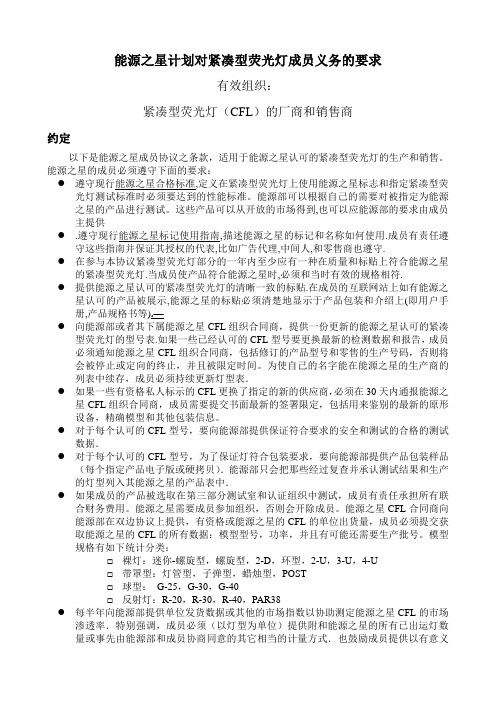
能源之星计划对紧凑型荧光灯成员义务的要求有效组织:紧凑型荧光灯(CFL)的厂商和销售商约定以下是能源之星成员协议之条款,适用于能源之星认可的紧凑型荧光灯的生产和销售。
能源之星的成员必须遵守下面的要求:●遵守现行能源之星合格标准,定义在紧凑型荧光灯上使用能源之星标志和指定紧凑型荧光灯测试标准时必须要达到的性能标准。
能源部可以根据自己的需要对被指定为能源之星的产品进行测试。
这些产品可以从开放的市场得到,也可以应能源部的要求由成员主提供●.遵守现行能源之星标记使用指南,描述能源之星的标记和名称如何使用.成员有责任遵守这些指南并保证其授权的代表,比如广告代理,中间人,和零售商也遵守.●在参与本协议紧凑型荧光灯部分的一年内至少应有一种在质量和标贴上符合能源之星的紧凑型荧光灯.当成员使产品符合能源之星时,必须和当时有效的规格相符.●提供能源之星认可的紧凑型荧光灯的清晰一致的标贴.在成员的互联网站上如有能源之星认可的产品被展示,能源之星的标贴必须清楚地显示于产品包装和介绍上(即用户手册,产品规格书等).—●向能源部或者其下属能源之星CFL组织合同商,提供一份更新的能源之星认可的紧凑型荧光灯的型号表.如果一些已经认可的CFL型号要更换最新的检测数据和报告,成员必须通知能源之星CFL组织合同商,包括修订的产品型号和零售的生产号码,否则将会被停止或定向的终止,并且被限定时间。
为使自己的名字能在能源之星的生产商的列表中续存,成员必须持续更新灯型表.●如果一些有资格私人标示的CFL更换了指定的新的供应商,必须在30天内通报能源之星CFL组织合同商,成员需要提交书面最新的签署限定,包括用来鉴别的最新的原形设备,精确模型和其他包装信息。
●对于每个认可的CFL型号,要向能源部提供保证符合要求的安全和测试的合格的测试数据.●对于每个认可的CFL型号,为了保证灯符合包装要求,要向能源部提供产品包装样品(每个指定产品电子版或硬拷贝).能源部只会把那些经过复查并承认测试结果和生产的灯型列入其能源之星的产品表中.●如果成员的产品被选取在第三部分测试室和认证组织中测试,成员有责任承担所有联合财务费用。
能源之星固态照明标准

版本1.1适用范围 (2)通用要求........................................................................................................... 错误!未定义书签。
灯具通用要求: (2)器件/阵列要求: (3)室外灯具要求: (3)电源要求 (4)包装要求 (4)A类:近期要求 (5)家居应用 (5)橱柜灯 (5)便携式作业灯 (6)嵌入式、明装、悬吊式筒灯 (6)带反射器的吸顶灯具 (6)凹圆暗槽灯 (7)Surface-mounted luminaires with directional head(s) (7)室外走廊灯 (7)室外阶梯灯 (7)室外庭院路灯 (8)室外杆装/臂装装饰灯具 (8)非家居应用 (8)嵌入式、明装、悬吊式筒灯 (8)架装橱柜作业灯 (9)便携式作业台灯 (9)洗墙灯 (9)立柱灯 (10)长期/未来性能目标 (10)标准文件 (10)认证过程 (12)产品变化说明 (12)光衰测试 (13)应用一、元件性能 (13)应用二、整灯性能 (13)电源测试 (14)详细认证测试过程 (14)质量保证测试 (14)生效日期 (15)后续更新说明 (15)版本1.1以下为采用固态照明(以下简称SSL)灯具产品的能源之星认证标准。
凡认证产品须满足下述所有标准要求。
适用范围✧以下标准要求针对以发光二极体为光源的(SSL固态照明)用于通用照明的灯具产品也包括具有明显装饰功能的产品;✧如果一个装饰类的SSL灯具具有明显的通用照明功能,则该标准也适用;✧该标准即适用于家居也适用于商业照明产品;✧该标准仅适用于接入市电的照明产品;✧该标准不适用于指示功用的SSL产品如交通灯、出口标志;✧该标准不适用于完全用于装饰用产品如节日灯✧该标准不适用于替换现有传统灯具内光源的SSL产品通用标准通用标准是依据现有的照明业参考标准和测试步骤制定出来的,新的或修正标准及测试流程的制定则正在进行中。
energy star 认证标准

Energy star 认证标准一、简介Energy star 认证标准是一种能源效率认证,由美国环境保护署(EPA)和美国能源部(DOE)联合制定。
该认证标准主要针对电子设备、家电、照明设备等产品,旨在鼓励制造商生产高效节能的产品,帮助消费者节约能源,降低碳排放。
二、认证标准的内容Energy star 认证标准主要包括以下内容:1. 能效要求Energy star 认证的产品需满足一定的能效要求,例如家用电器需满足特定的能耗标准,照明产品需满足特定的光效标准等。
这些要求旨在促使制造商生产更加节能的产品,从根本上降低产品的能源消耗。
2. 测试和认证制造商生产的产品需要经过独立认证机构进行测试,验证产品是否符合能效要求。
符合要求的产品才能获得 Energy star 认证,获得认证的产品可以在市场上使用 Energy star 标识。
3. 持续改进获得 Energy star 认证的产品需要进行持续改进,制造商需要不断优化产品的能效性能,以保持产品的认证资格。
这种要求促使制造商不断提高产品的节能水平,推动整个行业向更加节能的方向发展。
三、认证标准的意义Energy star 认证标准对制造商、消费者和环境都具有重要意义:1. 对制造商Energy star 认证标准鼓励制造商投入研发和生产高效节能的产品,有利于提升企业的竞争力。
获得 Energy star 认证的产品在市场上更具竞争优势,可以吸引更多消费者选择。
2. 对消费者Energy star 认证标准保证了产品的能效性能,消费者可以更加放心购买符合能效标准的产品。
购买 Energy star 认证的产品不仅可以节约能源开支,还有助于保护环境,是消费者理性购买的重要参考标准。
3. 对环境Energy star 认证标准的推广使用有助于降低全球能源消耗和碳排放,对保护环境具有积极意义。
通过推动节能产品的使用,可以减少对能源资源的需求,减少环境污染和气候变化的影响。
Engerstar标准版本-4.0
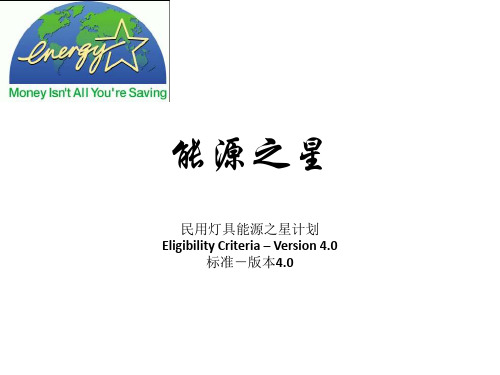
Lamp Start Time 打开灯保持照明平均时间为1或2秒 灯启动时间
Power Factor
功率系数
> 0.5
Lamp Current
Crest Factor
< 1.7
峰值因数
正常操作下,镇 流箱最高温度
不超过厂家规定的最大镇流箱温度值。
注:性能特性同UL热需求不一样,操作安全。所有合格灯 具要符合该规格,包括线型,悬挂型,天花板型,IC,ICAT和 非IC嵌入式筒灯等等,还有UL1598豁免的灯具。
带支架的灯具,显色指数符合以下要求; >80(精致型灯) >70(线型灯)
不带灯支架的灯具:其产品包装要符合该 表的“消费者认可包装”。
带支架的灯具,灯相关色温CCT如下:2700K, 3000K, 3500K, 4100K, 5000K, or 6500K. 不带灯支架的灯具:其产品包装要符合该表的 “消费者认可包装”。
• ILAC: International Laboratory Accreditation Cooperation (NVLAP MRA Signatory). 亚太实验室认可合作(NVLAP MRA 签名)
• Lam pholder: A component of a fixture, which supplies power to the lamp and also holds the lamp in place. 灯座:灯具的组成部分,为灯提供电 力以及固定灯的作用。
显示器认证标准
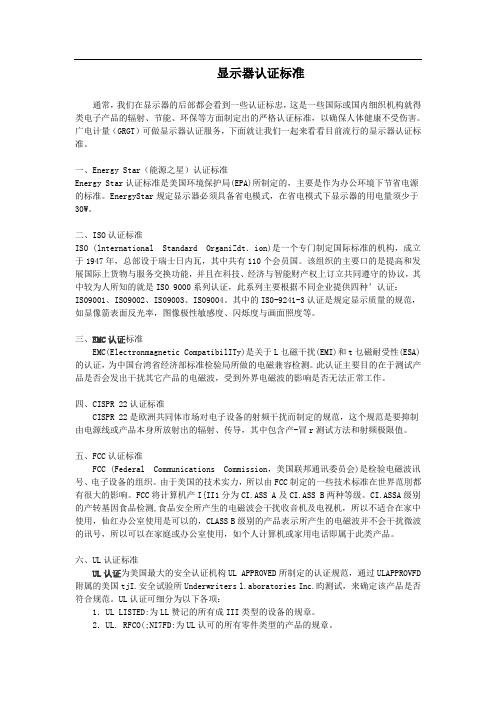
显示器认证标准通常,我们在显示器的后部都会看到一些认证标忠,这是一些国际或国内细织机构就得类电子产品的辐射、节能、环保等方面制定出的严格认证标准,以确保人体健康不受伤害。
广电计量(GRGT)可做显示器认证服务,下面就让我们一起来看看目前流行的显示器认证标准。
一、Energy Star(能源之星)认证标准Energy Star认证标准是美国环境保护局(EPA)所制定的,主要是作为办公环境下节省电源的标准。
EnergyStar规定显示器必须具备省电模式,在省电模式下显示器的用电量须少于30W。
二、ISO认证标准ISO (lnternational Standard OrganiZdt.ion)是一个专门制定国际标准的机构,成立于1947年,总部设于瑞士日内瓦,其中共有110个会员国。
该组织的主要口的是提高和发展国际上货物与服务交换功能,并且在科技、经济与智能财产权上订立共同遵守的协议,其中较为人所知的就是IS0 9000系列认证,此系列主要根据不同企业提供四种’认证:IS09001、IS09002、IS09003、IS09004。
其中的IS0-9241-3认证是规定显示质量的规范,如显像箭表面反光率,图像极性敏感度、闪烁度与画面照度等。
三、EMC认证标准EMC(Electronmagnetic CompatibilITy)是关于L乜磁干扰(EMI)和t乜磁耐受性(ESA)的认证,为中国台湾省经济部标准检验局所做的电磁兼容检测。
此认证主要目的在于测试产品是否会发出干扰其它产品的电磁波,受到外界电磁波的影响是否无法正常工作。
四、CISPR 22认证标准CISPR 22是欧洲共同体市场对电子设备的射频干扰而制定的规范,这个规范是要抑制由电源线或产品本身所放射出的辐射、传导,其中包含产-冒r测试方法和射频极限值。
五、FCC认证标准FCC (Federal Communications Commission,美国联邦通讯委员会)是检验电磁波讯号、电子设备的组织。
energy star4[1].0 简易教材
![energy star4[1].0 简易教材](https://img.taocdn.com/s3/m/e9170c1aff00bed5b9f31dc9.png)
Energy star4.0中规定的测试条件 star4.0中规定的测试条件
功率测量测试状况:CRT的像素格式应设定在75Hz的刷新频率驱动时之最 功率测量测试状况:CRT的像素格式应设定在75Hz的刷新频率驱动时之最 高解析度之最佳像素格式。对于所有LCD,除非制造厂商特别推荐使用一 高解析度之最佳像素格式。对于所有LCD,除非制造厂商特别推荐使用一 个不同频率,则测试时应使用此频率,否则LCD的更新频率应该设在60Hz。 个不同频率,则测试时应使用此频率,否则LCD的更新频率应该设在60Hz。 功率测量议定书:热机20分钟后开始测试,测量数据应该在瓦特读数在一 功率测量议定书:热机20分钟后开始测试,测量数据应该在瓦特读数在一 个3分钟期间内稳定之后取得。如果此瓦特数读数在一个3分钟期间内的变 分钟期间内稳定之后取得。如果此瓦特数读数在一个3 动性不超过1%,则可以被视为是稳定。在测量处于睡眠模式与关闭模式 动性不超过1%,则可以被视为是稳定。在测量处于睡眠模式与关闭模式 0.1W 之被测单位之用电时,应用精度为0.1W的仪器来测量。 之被测单位之用电时,应用精度为0.1W的仪器来测量。 产品的测试数量如下规定: 如果被测样品在所有三个操作模式下所测功率比energy star所规定的 如果被测样品在所有三个操作模式下所测功率比energy star所规定的 值还要低至少15%,则不需再抽测第二台样品 值还要低至少15%,则不需再抽测第二台样品 如果被测样品在任何一个操作模式下所测功率比energy star所规定的 如果被测样品在任何一个操作模式下所测功率比energy star所规定的 值低,但在15%以内,则再加测两台样品。任何一台均不可超过 值低,但在15%以内,则再加测两台样品。任何一台均不可超过 energy star 规定值。
能源之星标准测试项目清单
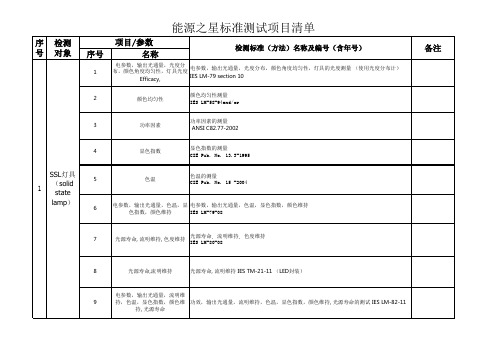
色指数,颜色维持
IES LM-79-08
7
光源寿命, 流明维持, 色度维持
光源寿命, 流明维持, 色度维持 IES LM-80-08 Nhomakorabea备注
8
光源寿命,流明维持
光源寿命, 流明维持 IES TM-21-11 (LED封装)
电参数,输出光通量,流明维
9
持,色温,显色指数,颜色维 功效,输出光通量,流明维持,色温,显色指数,颜色维持, 光源寿命的测试 IES LM-82-11
颜色均匀性测量 IES LM-58-94and/or
3
功率因素
功率因素的测量 ANSI C82.77-2002
4
显色指数
显色指数的测量 CIE Pub. No. 13.3-1995
SSL灯具
1
(solid state
lamp)
5
色温
色温的测量 CIE Pub. No. 15 -2004
6
电参数,输出光通量,色温,显 电参数,输出光通量,色温,显色指数,颜色维持
性灯具)
效,最小光输出
4 Integral
LED
Lamps,
Decorative
2
流明维护 Lumen Maintenance
流明维护测试 IES IES LM-80-08*
LM-79-08
section
9
3
快速应力循环测试
快速应力循环测试 IES LM-65-01
1
预热
灯具预热 ANSI C78.5-2003
7
40%额定寿命时的流明维持 40%额定寿命时的流明维持ANSI C78.5-2003
向)
2
光强分布,最小中心光束角 发光强度分布,最小中心光束角(PAR和MR16灯) IES LM-79-08 section 10 (PAR和MR16灯)
- 1、下载文档前请自行甄别文档内容的完整性,平台不提供额外的编辑、内容补充、找答案等附加服务。
- 2、"仅部分预览"的文档,不可在线预览部分如存在完整性等问题,可反馈申请退款(可完整预览的文档不适用该条件!)。
- 3、如文档侵犯您的权益,请联系客服反馈,我们会尽快为您处理(人工客服工作时间:9:00-18:30)。
CFLs合伙人协议的ENERGY STAR 适用标准应用单位:CFLs(紧凑型荧光灯)的生产商和分销商协议:以下为ENERGY STAR(能源之星)合作协议的条款,适用于ENERGY STAR 合格的CFLS的生产和/或交付。
ENERGY STAR的合伙人必须遵循以下要求:●遵循现有的ENERGY STAR合格标准(阐述了在CFLS上使用ENERGY STAR认证标记和CFLS测试标准必须符合性能标准)。
这些产品可能在市面上获得,或应DOE(能源部)的要求,由合伙人自愿提供●遵循现有的ENERGY STAR一致方针(描述了如何使用ENERGY STAR标记和名称)。
合伙人应遵守这些指南并且为确保合格机构(如广告商、经销商和分销商)符合此要求。
●具有资格或私有标志(凡ENERGY STAR合格的CFL型号),在协议中CFL部分的1年有效期内进行鉴定或打标。
当合伙人证明产品合格时,产品必须符合当时的标准。
●一旦合伙人递交了首次合格型号给ENERGY STAR,合伙人组织名称须作为ENERGY STAR合伙人()列出。
●提供ENERGY STAR合格的CFLS标签。
ENERGY STAR认证标志应清晰的显示在合格产品包装上,在合伙人的网站上和合格产品的文字说明中(即目录,说明书,产品规格等等)。
给出其ENERGY STAR合格的产品型号。
同时要求ENERGY STAR认证标记在合格产品的包装正面标记。
●在DOE季刊上,列出ENERGY STAR合格CFLs的更新清单。
合伙人如更新合格CFLS型号的试验数据或报告,修订型号和/或产品号,应及时通知DOE。
合伙人应提供季刊以列明ENERGY STAR CFL合伙人的清单;●如合格专用标签CFLs的指定供应商有改变,应在30天内通知DOE。
要求合伙人书面提供更新专用标签供应商资格表(确定新的原始设备生产商、型号、和其他包装信息);●提供合格CFL型号测试数据报告(由合格试验室提供)给DOE,证明荧光灯符合规定的安全和性能试验标准;●提供合格CFL型号的产品包装样品(包括电子或硬拷贝)给DOE,证明荧光灯符合包装要求。
DOE对产品试验结果和产品包装检查并确认后才将型号添加在合格产品清单上;●作为一独立的第3方认证和测试机构,ENERGY STAR要求合伙人参与鉴定,并将不参与认证和测试计划的合伙人从清单上剔除。
●每2年,将ENERGY STAR 合格CFL的单位出货数据提交给ENERGY STAR CFL分包商的DOE。
合伙人必须提交ENERGY STAR合格CFLs出货的总数量。
型号/设计应按以下类别进行分组:灯头型号:●中等螺口灯头(E26)●candelabra枝状大烛台螺口灯头(E12)●GU-24型式类型/花样:●裸露(Bare):小螺旋,螺旋、2-D,环形,双管,3管,方管●带罩(Covered): A-形(普泡型),bullet形(尖泡型),烛形,柱形;●球状(Globes): G-25(80mm),G-30(95mm),G-40(125mm);●反射镜(Reflectors): R-20(60mm),R-30(95mm),R-40(125mm),PAR38(120mm)。
功率型号或产品数量(如果可能)同时鼓励合伙人提供ENERGY STAR资格单位出货数据(从其生产线上每个型号总单位出货和ENERGYSTAR 产品总单位出货百分比中得到)。
每半年提供数据,由ENERGY STAR提供,电子表格格式(EXCEL)给ENERGY STAR CFL计划承包人,提交日期为:上半年不迟于2月15日(7-12月),下半年不迟于8月15日(1-6月)。
可由合伙人直接提供或通过直接与合伙人合作的第3方提供。
通报能源部关于可能部分或样式改变应在30天之内参与。
特别差别性能为取得DOE的额外认可和/或支持,合伙人可以考虑进行以下自愿措施并在改善过程中与DOE保持联系:●考虑公司设备中能效改进,并通过ENERGY STAR构建计划寻求构建基准;●购买ENERGY STAR合格产品。
修订工厂采购标准(含ENERGY STAR)。
提供正式采购合同给DOE以便其定期更新和协调。
雇员若购买产品用于家用时,应定期提供ENERGY STAR合格产品信息。
●确保使用ENERGY STAR监视器能更好的发挥能效管理作用,特别是在监视器安装和使用后。
●提供ENERGY STAR的一般信息给雇员(其工作与现在的ENERGY STAR合格产品型号的开发、销售和服务有关)。
●在合伙人网站和其他推广材料上标记ENERGY STAR标志。
如果在合伙人网站上有ENERGY STAR信息,DOE可提供联接。
●提供简要计划给DOE,略述合伙人除上述要求外采取的行动。
提供DOE计划措施,DOE可能在ENERGY STAR网页中ENERGY STAR时事通讯上列出此类信息,通过这些方法,DOE可以协调、沟通,和/或促进合伙人的能动性。
计划应简单,如提供计划措施清单或合伙人希望DOE知悉的重要事件。
例如,活动可能包括:(1)通过在2年内更换整个生产线以符合ENERGY STAR指令,以便更好的生产ENERGY STAR合格产品;(2)1年内展示2次在仓产品,证明能效的经济和环境效益;(3)提供有关ENERGY STAR合格产品的节能特性和操作特性信息给使用者(经过网站和说明书);和(4)通过与DOE合作(在印制宣传品和现场发布会上),巩固ENERGY STAR合作意识和品牌理念。
●每季度提供书面更新给DOE,告知合伙人为加强ENERGY STAR合格产品所做的努力。
ENERGY STAR对CFLs的要求ENERGY STAR合格标准能效标准—版本4.0以下为ENERGY STAR CFLs—版本4.0的产品要求,产品必须符合以下要求。
1)范围:此ENERGY STRAR CFL标准包括对自镇流、带罩CFLs和灯系统的要求,包括:A.中等螺旋,烛台螺旋,或GU-24灯头,带整体电子镇流器荧光灯;产品需要(Products that requirean adaptor to convert a medium socket to a candelabra socket are excluded.)B.最大直径为9英寸的环型灯和方形灯(最大边长8英寸带经过测试的有中等螺旋灯头或GU-24灯头和电子镇流器,并与灯管一起包装。
)C.带内置电子镇流器的中等螺旋灯头,烛台螺旋或GU-24灯头的荧光灯,其裸露荧光管上有透明罩。
罩可为球状、弹丸状、梨状、鱼雷状、蜡烛状或其他形状。
Products that require an adaptor to convert a medium socket to candelabra socket are excluded.D.带内置电子镇流器的中等螺旋灯头,烛台螺旋或GU-24灯头CFLs,其反射镜可打开或关闭。
被接触或应被罩壳罩住。
* 此ENERGY STAR标准的目的是鼓励消费者用节能紧凑型荧光灯取代白炽灯。
ENERGY STAR CFLs标准主要是证明产品适用于住宅和商业应用。
2)定义A.ANSI:美国国家标准化组织。
B.A2LA:美国合格实验室协会。
C.平均额定寿命(Average rated lamp life):生产厂规定的时间长度,50%的灯达到其单独的寿命值。
D.烛台型紧凑荧光灯:一个自镇流紧凑荧光灯带一个螺口灯头,确定使用E12灯头。
E.CIE:国际照明委员会。
F.显色指数:G.相关色温(CCT):H.GU-24灯头整灯:使用GU-24灯头的I.ICAT Fixture:隔热天花板空气紧密安装。
J.IESNA:北美照明工程协会。
K.Kelvln:测量温度的基本单位,在光源中是度量色温,用来指示光源产品颜色。
L.初始性能值:100小时老化时间段末的光度测定和电气特性。
M.灯颜色:灯的颜色特性,由颜色外观和颜色划分决定N.颜色外观:灯管的实际颜色称为颜色外观,依据CIE No.13.3-1995的建议,在光谱3刺激值(颜色坐标)术语中有规定。
O.演色性:灯管的实际颜色称之为演色性。
P.流明:光源发出光通量数量的单位。
Q.流明维持率:指电光源使用一段时间后的光通量与其初始值之比。
R.光效:灯的流明输出与总功率输入之比。
S.迈克亚当颜色椭圆:一个椭圆区域详细说明颜色坐标使用一个质心,一个倾斜角相对于水平轴。
定义水平变化。
T.中等螺旋灯:E26灯头的螺旋灯。
U.NVLAP:国家认可实验室。
V.室外反射镜:一种反射型CFL主要用在室外或UL列出的潮湿的地方。
W.OSHA:职业安全健康管理。
X.功率因数:实际功率除表观功率(也就是均方根输入瓦特和镇流器的均方根输入电流的乘积)。
Y.专有标签的CFL: ENERGY STAR合格CFL灯管,产品上除了贴有产品生产商商标,还贴有ENERGY STAR合伙人的商标。
Z.额定流明输出:生产商规定的初始流明额定(100小时)。
AA.额定供给频率:标在灯上的频率。
BB.额定电压:标在灯上的电压。
CC.额定功率:标在灯上的功率。
DD.退出或中止产品:符合ENERGY STAR的产品,但已不再生产(到清单上的日期为止),但仍可在市场上看到。
EE.开始时间—开关接通后灯管启动并完全点亮的时间。
FF.运行时间—开关接通后灯管达到起稳定光通量80%的时间。
GG.开始温度—灯管可靠启动的最小和最大温度。
3)参考标准:除非ENERGY STAR CFL(ENERGY STAR紧凑型荧光灯)的标准更为严格,否则ENERGY STAR 合格的紧凑型荧光灯和灯管系统应符合以下标准的相关条款,:ANSI C78.901-2001 美国国家标准,电灯-单端荧光灯—尺寸和电气特性ANSI C78.5-1997 电灯.荧光自镇流灯.性能指南ANSI C78.375-1997 荧光灯电气测量指南ANSI/IEEE C62.41-1991(1991年5月1日)低压交流电力网电涌推荐实施规程CIE No.13.3-1995 测量和规定光源演色性的方法CIE No.18.2-1983 自然光度测定原理IESNA LM-9-1999 荧光灯电气&光度测定方法IESNA LM-40-2001 荧光灯寿命性能试验方法IESNA LM-65-2001 单端紧凑型荧光灯寿命试验IESNA LM-66-00-2000 单端紧凑型荧光灯电气和光度测定方法UL 1993-1993 自镇流灯及其适配器注意:测试用基准镇流器不应使用完整的带镇流器的灯。
这些灯应测量在使用完整镇流器在120V60Hz。
ENERGY STAR合格的紧凑型荧光灯和灯管系统必须符合US联邦商务委员会(16 CFR 第305.1-19部分;更多信息请的登陆:/bcp/conline/pubs/buspubs/applince/htm#howcomply或/nara/cfr/cfrhtml 00/Title 16/16cfr305 00.html和US联邦商务委员会EMI要求 47 CFR,包括第2部分和第18部分(对于消费RF照明设备)。
